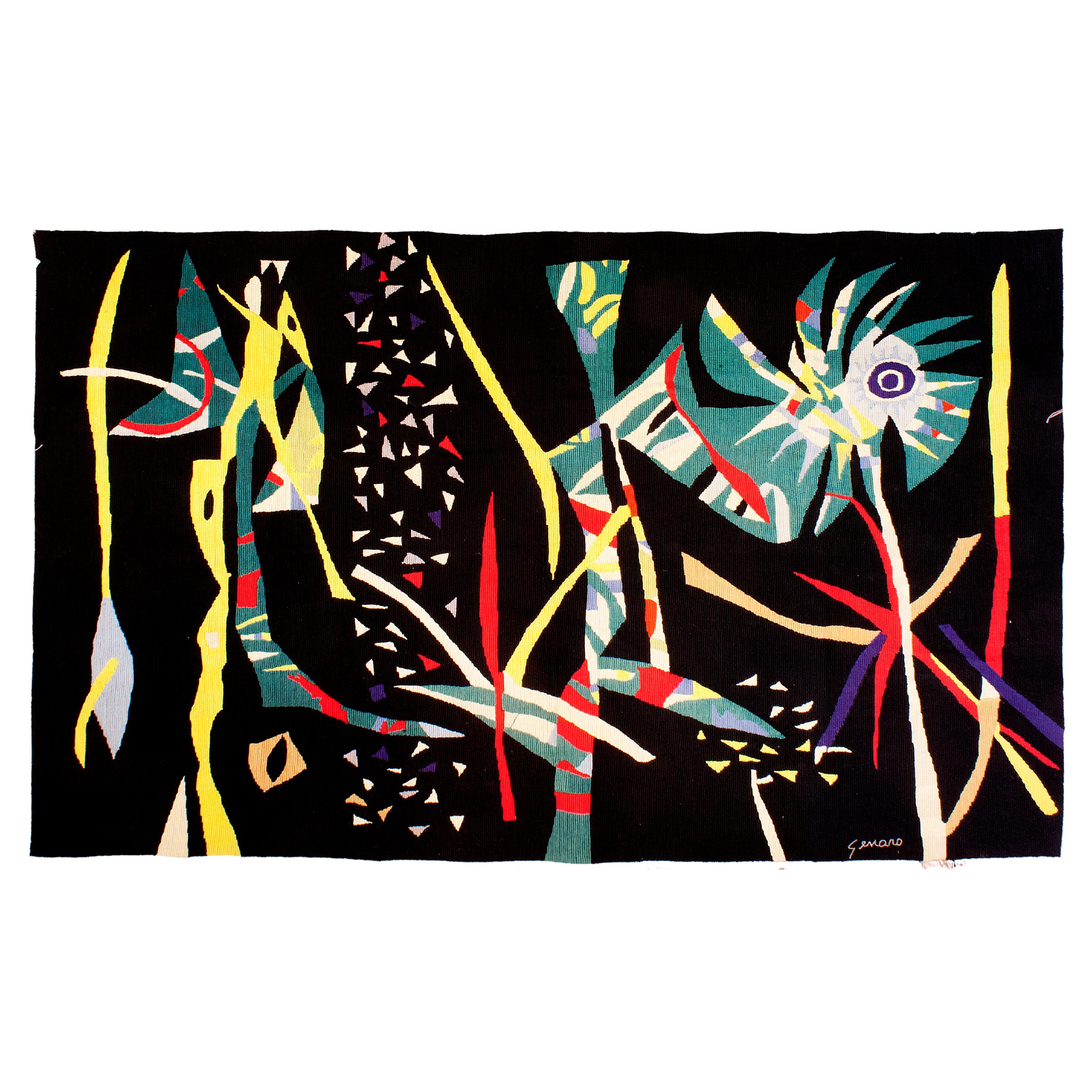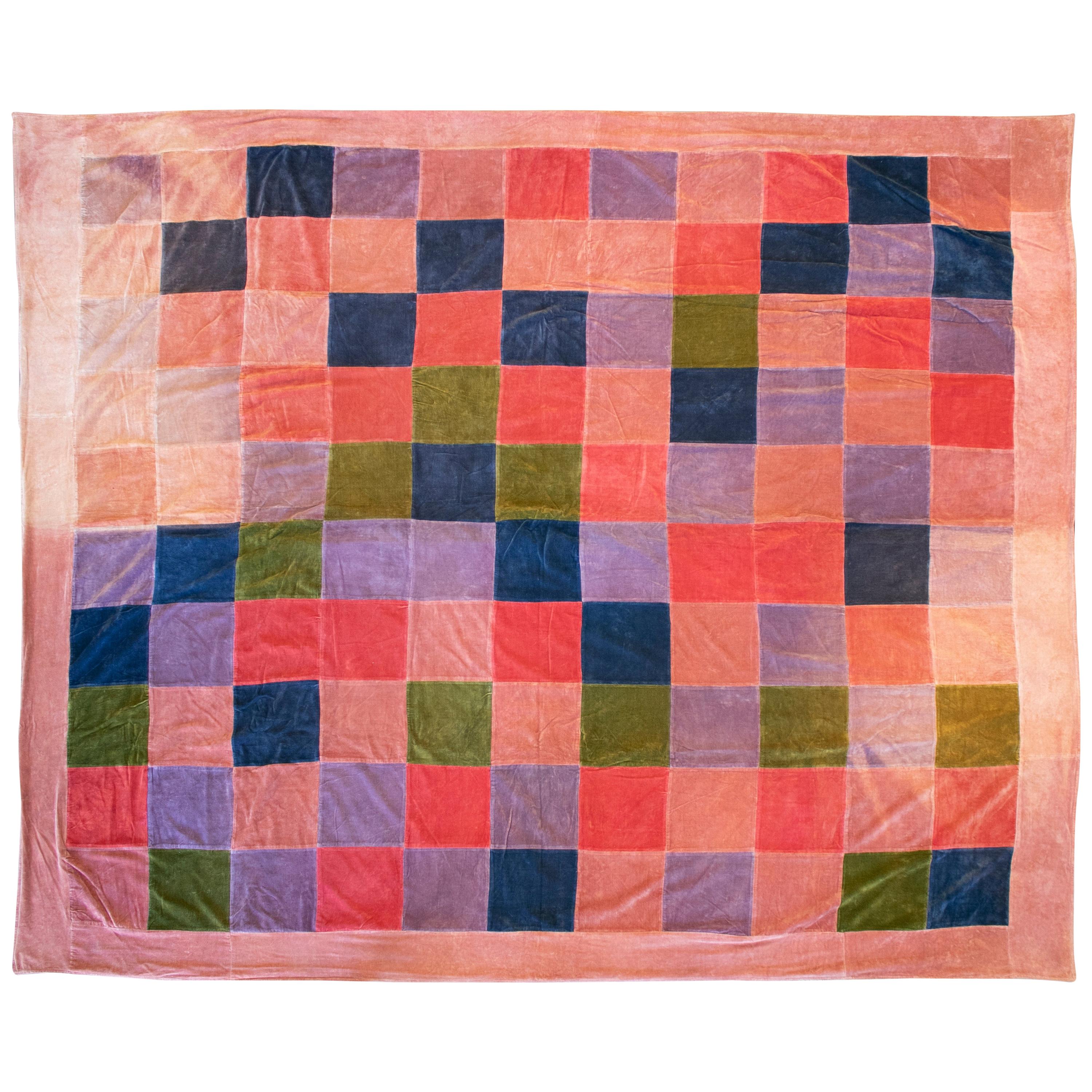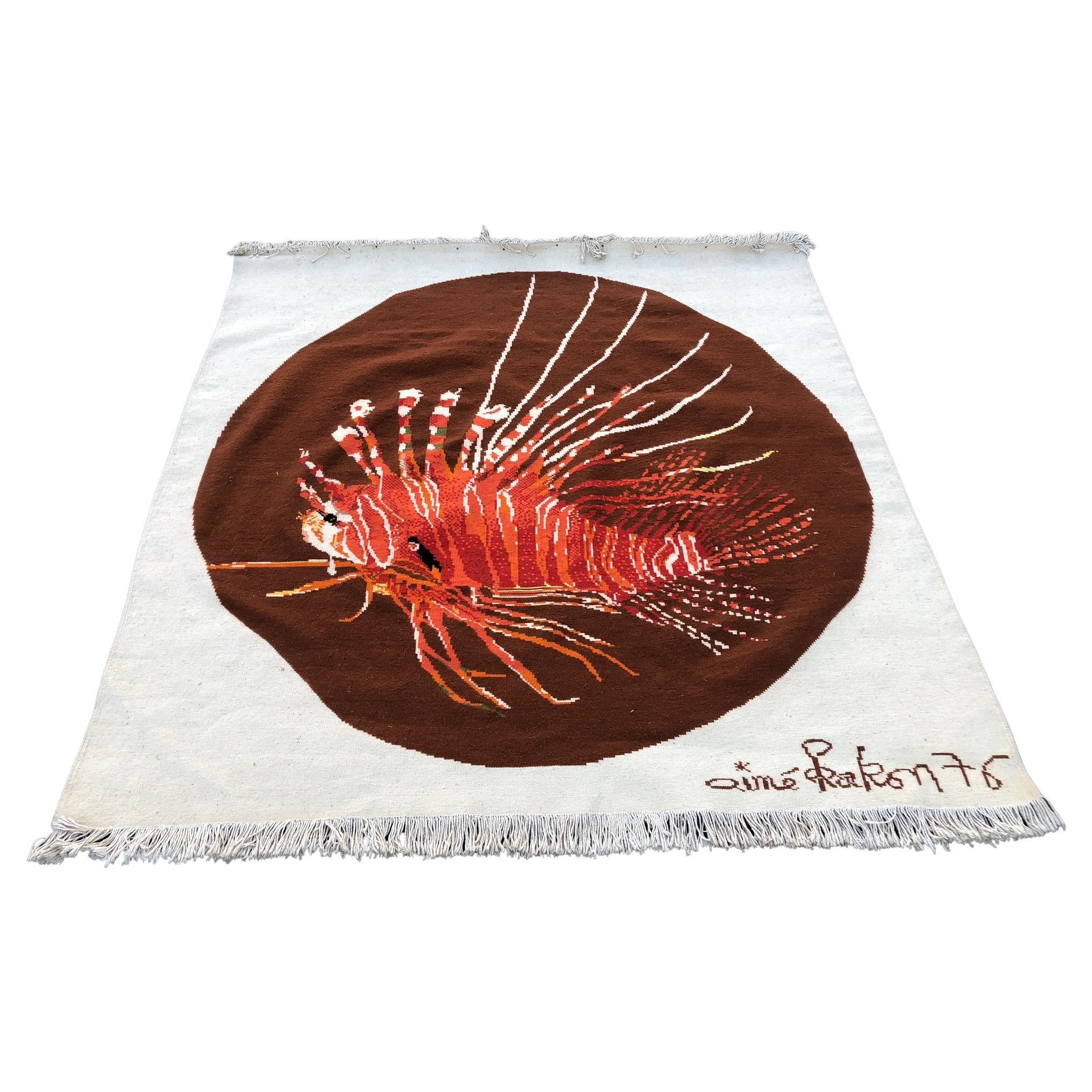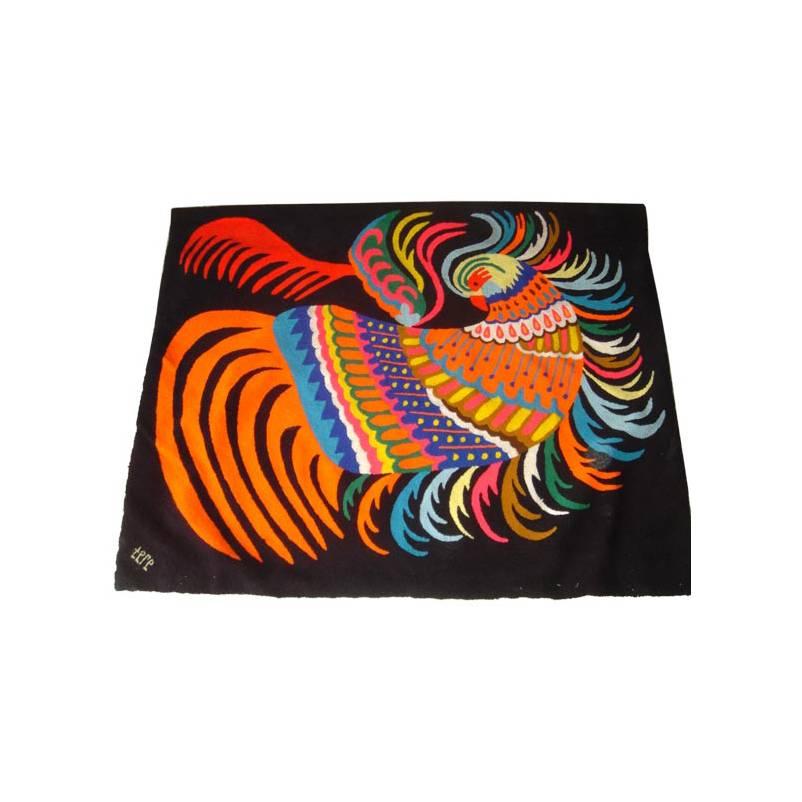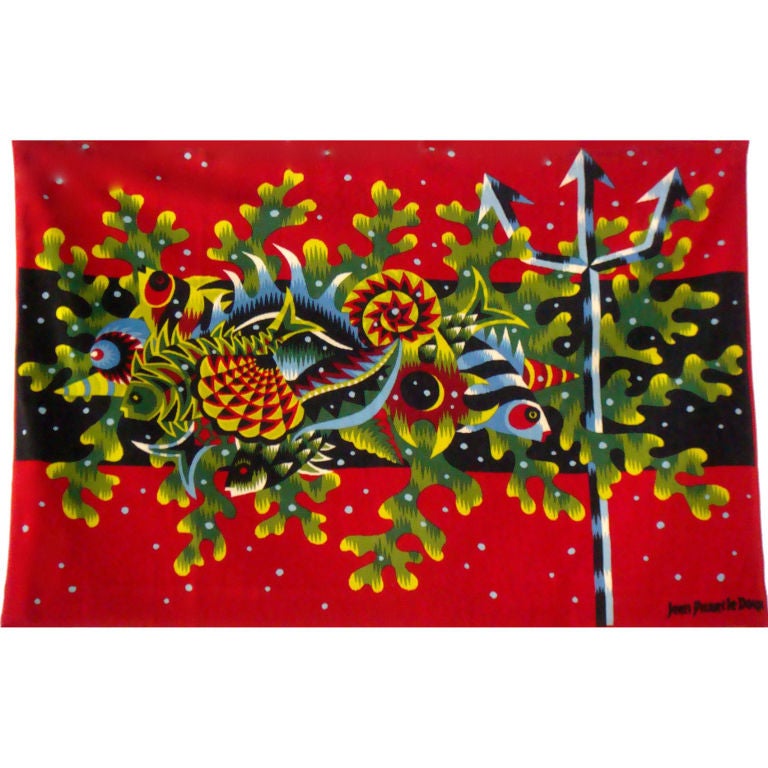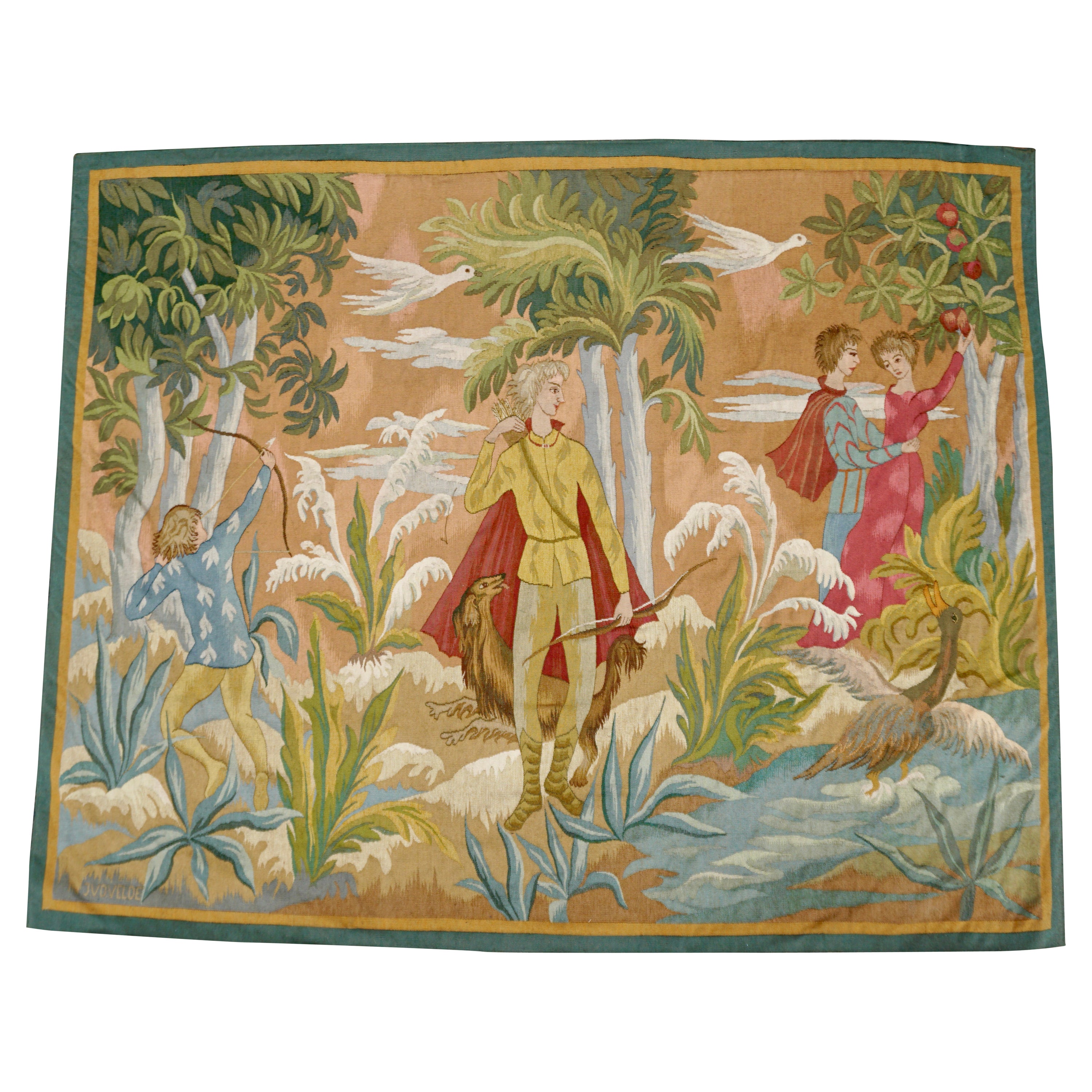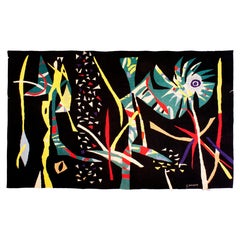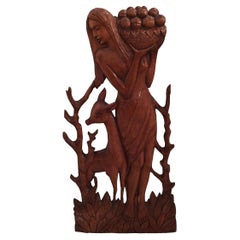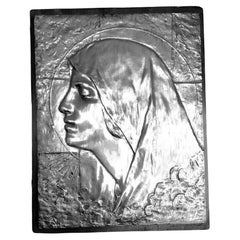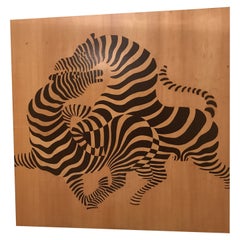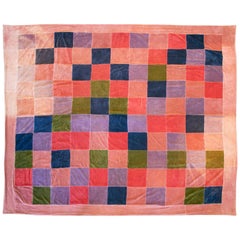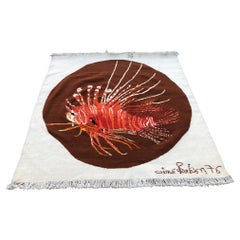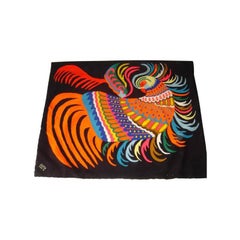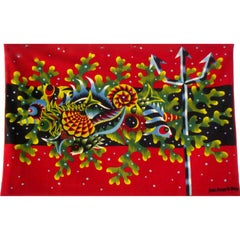Items Similar to Tapestry, Brazilian Artist, 1980 Sign Renot
Video Loading
Want more images or videos?
Request additional images or videos from the seller
1 of 22
Tapestry, Brazilian Artist, 1980 Sign Renot
About the Item
Tapestry Design Renot
Brazilian artist 1980
The tapestry is restored.
Sign:
Renot 1980 Bahia Brazil original
Atelier Studio Renot
Salvador- Bahia
Renot - Reinaldo Eliomar de Freitas Marques da Silva
was a Brazilian artist who was born in 1932. Renot's work has been offered at auction multiple times. The artist died in 2021.
tapestry, designed in canvas and embroidered with half a wool stitch, by Renot, who, together with Genaro de Carvalho, is part of the group of the most important upholsterers in Bahia.
Renot participated in the International Tapestry Exhibition held in Geneva, Switzerland, 1974. And in several exhibitions in Brazil, among others, in the Triennial of Tapestry held at the Museum of Modern Art of São Paulo (MAM/SP) in March/April 1979 and abroad, among others, in Rome, London and Hamburg. His works are part of the collection of several national and international museums and private collections in Brazil and abroad.
Renot work follows an abstract line and instinctively seeks to extract the "most beautiful and sensual" of human nature, from the fauna and vegetation of Recôncavo Baiano to the popular festivals and mansions of Bahia. His colorful canvases are almost like embroidery with brushes. Renot, in addition to his works in Tapestry, is also known in the art scene for his paintings.
in 1957, at the age of 25, he began to paint inspired by the cangaceiro Lampião, a character who marked the Northeastern imagination with his adventures. In 1960 he started a movement in Salvador that encouraged the local art market. In partnership with friends, he founded the Manoel Querino Gallery, which hosted shows by great Brazilian artists who exhibited with him: Di Cavalcanti, Djanira, Manabu Mabe, Aldemir Martins, Antonio Bandeira and many others.
The name Renot was created by the direction of the Bahia newspaper in the 60s for the signature of the social column entitled “Gran Mond”, in which the artist gave notes on Bahian society, achieving enormous prestige. The column signed by him was transferred to the Estado da Bahia newspaper, belonging to the Diários Associados complex. At this time, Renot started directing a program on TV Ipatuã, in addition to running another on radio Sociedade da Bahia, interviewing personalities of the time. In 1967 he was already loved by his audience. In 1969 he was invited by the then Governor of São Paulo to participate in the collective exhibition at the inauguration of Paço das Artes. Among the greatest supporters of his work were the director of the State Museum Carlos Eduardo da Rocha and Jorge Amado.
At the end of the 60s, he moved permanently to São Paulo and, in 1972, he opened the legendary Galeria Renot in Jardins, where he promoted exhibitions by Francisco Rebolo, Aldemir Martins, Pennacchi, José Antonio da Silva, Di Cavalcanti, Cícero Dias, Rubens Gerchman , among dozens of great artists. Renot has always been a man dedicated to culture, with his attention turned especially to the visual arts, being a reference in the artistic world. He played a prominent role in publicizing and marketing the work of dozens of artists.
In 2008, the exhibition “Renot em 20” was held at Cristal Pizza Bar, presenting the artist's works in various stages of his career and a large puzzle based on one of his works, which was assembled in the exhibition.
Currently, Renot has devoted himself entirely to his own artistic creation in his private studio, after more than 60 years dedicated to art and the market. Today the artist works intensely with his painting, also dedicating himself to the creation of tapestries. They are developed differently from the classic technique, in which you draw on a card and transfer the image to the screen. Renot draws directly on the fabric, which guarantees the exclusivity of the work. In his tapestries, the artist portrays the houses of the old city of Salvador, the popular festivals of Bahia, the birds, fauna and vegetation of the Recôncavo Baiano. After choosing the colors, the artist embroiders the canvas.
In 2014, after decades of dedication, Renot ended the activities of Galeria Renot, dedicating himself entirely to his work. Currently, large companies are looking for their creations to incorporate them into corporate images.
The artist shows nature with sensuality, combining shades of color that are hidden behind the houses or sprout from the tropical vegetation of the Recôncavo. In his works, Brazilian reality is characterized in all its mystery, exoticism and unique aspects. The world created by Renot is oneiric, sensual and magical, where fantasy and reality are indivisible. In the work of this great artist there is a predominance of the flora and fauna of Bahia, always with the strong presence of colors and, in particular, blue and its variations.
Exhibitions
2015 – Renot Exhibition – Light of the Tropics, Canvas Art Gallery, São Paulo, SP
1983 - Collective exhibition Selection of Contemporary Artists, Monte Líbano Club, São Paulo, Brazil.
1982 - Individual exhibition at the United States Cultural Union Brazil, São Paulo, Brazil.
1981 - Special Events and Foley's group exhibition, Houston, Texas, USA.
1980 – Screening of the Short Film ‘Renot Bahia Brasil’ at the Museum of Image and Sound, São Paulo, Brazil.
1979 - Group exhibition at the Basf Group at the São Paulo Museum of Art, São Paulo, Brazil.
1978 - Solo exhibition at Sea Gallery, San Francisco, California, USA.
1977 - Individual exhibition at Salão Topázio, Hotel Hilton, São Paulo, Brazil.
1976 - Solo exhibition at Galeria Projecta, São Paulo, Brazil.
1976 - Solo exhibition at Debret Gallery, Paris, France.
1975 - Solo exhibition at Sensus Gallery, São Paulo, Brazil.
1975 - Collective exhibition at Bonette Gallery, Turin, Italy.
1974 – Solo exhibition at Tryplique Gallery, Geneve, Switzerland
1974 – Solo exhibition at Oswaldo Centoria Gallery, Buenos Aires, Argentina.
1973 – Individual exhibition at the Cultural Foundation, Brasília, Brazil.
1973 – Collective exhibition at the Bank of Boston, São Paulo, Brazil.
1972 – Individual exhibition at the Secretary of Tourism, Culture and Sports, in Santos, São Paulo.
1972 – Collective exhibition at the Caribbean Creative Arts Festival - Carifesta - Georgetown, British Guiana.
1971 – Represented Brazil at the centenary festival in the city of York, England.
1971 – Individual exhibition, in Hamburg, Germany, promoted by the English dealer Aliska Bierer.
1971 – Collective exhibition at the Alberto Bonfiglioli Gallery, in São Paulo, Brazil.
1970 – Work exhibited at Galeria Marino in Rome, Italy.
1970 – Exhibition at the ‘O Girassol’ store in Salvador, Bahia, Brazil.
1970 – Solo exhibition at the Leopoldina Art Gallery, in Porto Alegre, Rio Grande do Sul, Brazil.
1970 – Collective exhibition promoted by the English dealer Ann Wace in London, England.
1969 – Collective Exhibition at the inauguration of Paço das Artes in São Paulo, Brazil.
We have specialized in the sale of Art Deco and Art Nouveau and Vintage styles since 1982.If you have any questions we are at your disposal.
Pushing the button that reads 'View All From Seller'. And you can see more objects to the style for sale.
Why are there so many antiques in Argentina?
In the 1880 – 1940 there was a grate wave of immigration encouraged by the periods of war that were taking place.
1st World War took place between 1914 and 1918
2nd World War took place between 1939 and 1945
The immigrants options were New York or Buenos Aires. Tickets were cheap and in Buenos Aires they were welcomed with open arms, as it was a country where everything was still to be done.
Argentina was the country of new opportunities, labour was needed and religious freedom was assured, in many cases the of the family travel first until they were settled and then the rest of the family members join them.
In the immigrant museum “Ellis Island Immigrant Building” in New York you can se the promotional posters of the boats that would take them to a new life.
Between the years 1895 and 1896, Argentina had the highest DGP (gross domestic product) per capita in the world according to the Maddison Historical Statistics index, this situation arose due to the large amount of food being exported to European countries, which were at war.
The Argentinean ships left the port of Buenos Aires with food, but they returned with furniture, clothes and construction elements, (it´s common to see this the old buildings of the historic neighbourhood of San Telmo, the beams with the inscription “Made in England)”, as well as many markets that were built in Buenos Aires, such us the San Telmo Market, whose structure was brought by ship and afterwards assembled in 900 Defensa Street.
With the great influence of European immigrants living in the country, the children of the upper classes travelled to study in France, resulting in the inauguration of “La Maison Argentinienne”, on 27th of June 1928, in the international city of Paris, which hosted many Argentinians that were studying in Frace.
It´s the fourth house to be built after France, Canada and Belgium, being the first Spanish-speaking one. Still in place today (17 Bd Jourdan, 75014, Paris, France). Many of the children of these wealthy families who attended international art exhibitions, museums and art courses abroad, took a keen interest in the European style. This is why Buenos Aires was at the time referred as “The Paris of South America”.
Between the years 1890 and 1920 more than a hundred Palaces were built on Alvear Avenue the most exclusive avenue in Buenos Aires. Today some of these palaces have been transformed into museums, hotels and embassies.
In the year 1936, the Kavanagh building was inaugurated, it was the tallest reinforced concrete building in South America.
During 1994 the American Society of Civil Engineers distinguished it as an “international engineering milestone”, and it´s now considered a World Heritage of Modern Architecture.
At the time was common to hire foreign architects such as Le Corbusier, who visited Buenos Aires/Argentina in 1929 and in 1948 he drew up the blueprints for a house built in La Plata City (which was declared a World Heritage Site).
In 1947, the Hungarian architect Marcelo Breuer designed “Parador Ariston” in the seaside city of Mar del Plata. After an Argentinean student at Harvard University convinced him to come to Argentina. He worked on an urban development project in the Casa Amarilla, area of La Boca.
The Ukrainian architect, Vladimiro Acosta, arrives in Argentina in 1928 and worked as an architect until que moved to Brazil.
Antonio Bonet, a Spanish architect who worked with Le Corbusier in Paris, arrives in Argentina in 1937, where he carried out several architectural works and in 1938 designs the well-known BFK chair.
Andres Kálnay, of Hungarian origin, made around 120 architectural masterpieces, among which the former Munich brewery stands out, he even made the furniture’s design.
The German architect, Walter Gropius, director of the Bauhaus, lived in Argentina, where he wrote articles for “Sur” magazine and founded in Buenos Aires, an architectural firm with Franz Möller, who was also an architect, where he built two houses.
At the same time several famous designers decided to immigrate to Argentina, among them we can find the well-known French designer, Jean-Michel Frank, who arrived in the country in 1940 and also worked for the Rockefeller family.
Special pieces were made, which were sold exclusively in the country, such as the well-known German company “WMF”, who sold their products by catalogue, which were chosen by the ladies of high society in the list of wedding gifts, as well as the pieces designed by Christofle.
The Swiss sculptor Alberto Giacometti, made special pieces for Argentinean mansions.
In 1904 the first Jansen branch outside Paris was established in Buenos Aires, as the Argentinean clientele demanded a large amount of furniture, from the end of the 19th century to the mid-20th century.
In 1970, the brand Rigolleau Argentina made pieces authorised by Lalique.
The brands Maple and Thompson also set up shop in the country.
The French plastic artist, Marcel Duchamp moved to Argentina in 1918-1919.
Glass signed Gallé, Charder, Leverre, Schneider, Muller and other French firms. They were bought in flower shops and were given to ladies with beautiful floral arrangements.
Some furniture manufacturers travelled to international fairs and bough the patterns to produce the furniture in Argentina, such as the furniture firm Englander and Bonta, who bought the patterns ins Italy.
It is worth mentioning that in Argentina we have the largest community of Italians outside of Italy, as it is estimated that 70 percent of the inhabitants have at least one Italian descendant, followed by Spanish immigrants.
The most Important furniture stores in Argentina:
Comte is founded in 1934 (under the direct management of Jean Michel Frank in 1940).
Nordiska (Swedish company established in 1934).
Churba in 1960, a company that brought foreign designers to present their furniture in the country:
Denmark: (Arne Jacobsen, Finn Juhl, Bender Madsen, Ejner Larsen, Poul Kjaerholm, Hans Wegner)
Sweden: (Hans Agne Jakobsson, Gustavsberg)
United States: (Herman Miller)
Finland: (Lisa Johansson, Folke Arstrom, Tapio Wirkkala, Alvar Aalto, Timo Sarpaneva)
Swedish Factory: (Orrefors)
Italy: (Littala, Vico Magistretti, Emma Gismondi, Gae Aulenti, Angelo Mangiarotti, Elio Martinelli, Gianna Celada, Angelo Mangiarotti, Mario Bellini, Carlo Scarpa)
Finland: (Olivia Toikka)
Plata Lappas (Lappas Silver): a goldsmith shop founded in 1887 in Argentina by Alcibiades Lappas of Greek origin.
In 2019, in Argentina took place “the Art Deco world congress”, in which we participated as hosts invited by Geo Darder, founder of the Copperbridge – Foundation, in which prominent people from all over the world attended to learn about Art Deco in Argentina.
Argentina currently has more than 100 Art Deco buildings and another 90 Art Nouveau buildings throughout the city of Buenos Aires.
Argentina is a country that has not been involved in many wars, which is why it has been a refuge for works of art and antiques from different periods of time, unlike European countries. That is way many collectors, museums and antique dealers from all over the world visit it, you should not miss the opportunity to visit this great country.
Laura Guevara Kjuder, architect.
- Dimensions:Height: 35.24 in (89.5 cm)Width: 51.97 in (132 cm)Depth: 0.36 in (9 mm)
- Style:Space Age (Of the Period)
- Materials and Techniques:
- Place of Origin:
- Period:1980-1989
- Date of Manufacture:1980
- Condition:Wear consistent with age and use.
- Seller Location:Ciudad Autónoma Buenos Aires, AR
- Reference Number:Seller: M-1stDibs: LU6785234364102
About the Seller
5.0
Vetted Professional Seller
Every seller passes strict standards for authenticity and reliability
Established in 1982
1stDibs seller since 2022
35 sales on 1stDibs
Typical response time: <1 hour
- ShippingRetrieving quote...Shipping from: Ciudad Autónoma Buenos Aires, Argentina
- Return Policy
Authenticity Guarantee
In the unlikely event there’s an issue with an item’s authenticity, contact us within 1 year for a full refund. DetailsMoney-Back Guarantee
If your item is not as described, is damaged in transit, or does not arrive, contact us within 7 days for a full refund. Details24-Hour Cancellation
You have a 24-hour grace period in which to reconsider your purchase, with no questions asked.Vetted Professional Sellers
Our world-class sellers must adhere to strict standards for service and quality, maintaining the integrity of our listings.Price-Match Guarantee
If you find that a seller listed the same item for a lower price elsewhere, we’ll match it.Trusted Global Delivery
Our best-in-class carrier network provides specialized shipping options worldwide, including custom delivery.More From This Seller
View AllTapestry Genaro Antônio Dantas de Carvalho, Brazilian Artist, 1960
By Genaro de Carvalho
Located in Ciudad Autónoma Buenos Aires, C
Tapestry Genaro Antônio Dantas de Carvalho
Brazilian artist 1960
Upholsterers, painter, designer. Genaro Antonio Dantas de Carvalho began his painting studies with his father. In 1944, he went to Rio de Janeiro and studied drawing with Henrique Cavalleiro at the Brazilian Society of Fine Arts. He is considered one of the main activists for the renewal of art in Bahia, along with Carlos Bastos, Caribé and Mario Cravo...
Category
Vintage 1960s Brazilian Space Age Tapestries
Materials
Tapestry
Amaizing Woman, 1940, France, Material, Wood, Sign, Zadra
Located in Ciudad Autónoma Buenos Aires, C
Amaizing woman
Material: wood
Country: France
We have specialized in the sale of Art Deco and Art Nouveau and Vintage styles since 1982. If you have any questions we are at your dis...
Category
Vintage 1930s Argentine Art Deco Decorative Art
Materials
Wood
Art Deco Virgin, 1930, Sign : T. Fosca , Foundry: Gottuzzo Y Piana
Located in Ciudad Autónoma Buenos Aires, C
Virgin
Sign : T. Fosca
Foundry: Gottuzzo y Piana
Material: silver plated bronze
The foundry was founded in 1884, during the presidency of Julio Roca in Buenos Aires, Argentina b...
Category
Antique 1830s Argentine Art Deco Decorative Art
Materials
Bronze
Amaizing Marquetry Optical Zebras, 1950, France, Material: Wood
Located in Ciudad Autónoma Buenos Aires, C
Amaizing Marquetry
Material: wood
Country: France
We have specialized in the sale of Art Deco and Art Nouveau and Vintage styles since 1982.If you have any questions we are at your ...
Category
Vintage 1950s French Space Age Decorative Art
Materials
Wood
Amaizing Marquetry Optical Ball, 1950, France, Material: Wood
Located in Ciudad Autónoma Buenos Aires, C
Amaizing Marquetry
Material: wood
Country: France
We have specialized in the sale of Art Deco and Art Nouveau and Vintage styles since 1982.If you have any questions we are at your ...
Category
Vintage 1950s French Space Age Decorative Art
Materials
Iron
Marquetry Optical Ball, 1950, Materials: Wood and iron, France
Located in Ciudad Autónoma Buenos Aires, C
Amaizing Marquetry
Materials: wood and iron
Country: France
We have specialized in the sale of Art Deco and Art Nouveau and Vintage styles since 1982.If you have any questions we ar...
Category
Vintage 1950s French Space Age Decorative Art
Materials
Iron
You May Also Like
1980s Indian Hand Sewn Patchwork Tapestry
Located in Marbella, ES
1980s Indian hand sewn patchwork tapestry.
Category
Late 20th Century Indian Tapestries
Materials
Fabric
Wall tapestry by Aimé Kakon
Located in Brooklyn, NY
Exceptional tapestry designed by Aimé Kakon in 1976
Architect, sculptor, ceramicist, visual artist, Aimé Kakon is an artist in his own right.
His work is timeless, his graphics as w...
Category
Late 20th Century French Space Age Tapestries
Materials
Wool
$3,600 Sale Price
20% Off
Tere Tapestry
By Tere
Located in Brooklyn, NY
Original Tere tapestry from the 1970's
Category
20th Century Venezuelan Shaker Decorative Art
Materials
Wool
$2,400 Sale Price
20% Off
Signed French Jean Picart Le Doux Woven Wool Tapestry Mid-Century Modern 1940
By Jean Picart Le Doux
Located in Miami, FL
Huge French Mid-Century Modern handwoven wool Tapestry Titled, L Aquarium.
Original signature by the artist in the lower right corner, Jean Picart Le Doux.
Category
Mid-20th Century French Mid-Century Modern Tapestries
Materials
Wool, Cotton
Belgian Figural Tapestry
Located in Antwerp, BE
Finely worked in colored woolens and depicting hunters and two lovers, signed: 'J.V.D.VELDE'
Date;
c. 1950-70's
A charming tapestry in very good condition and representative o...
Category
Mid-20th Century Belgian Mid-Century Modern Tapestries
Materials
Wool
Kennedy Bahia Brazilian Modern Wall Tapestry, 1980s
By Kennedy Bahia
Located in Miami, FL
Woven wall tapestry by Brazilian textile artist Kennedy Bahia circa 1980.
Hummingbird, butterflies and flowers.
“Known nationally and internatio...
Category
Late 20th Century Brazilian Mid-Century Modern Tapestries
Materials
Textile
